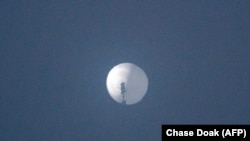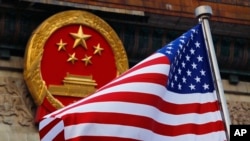The U.S. Defense Department said Friday another Chinese surveillance balloon is sailing over Latin America, two days after a similar high-altitude balloon was discovered traveling over the United States.
Pentagon press secretary Air Force Brigadier General Pat Ryder said in a statement to media outlets “we are seeing reports of a balloon transitioning Latin America.”
“We now assess it is another Chinese surveillance balloon,” he said.
Earlier Friday, Ryder told reporters at the Pentagon that the balloon sailing over the United States is there for surveillance — in violation of U.S. airspace and international law – despite China’s insistence it is designed for meteorological research.
He said he could not go into specifics but said that U.S. defense officials know it is a surveillance balloon and have conveyed their displeasure to Chinese officials “at multiple levels.”
Ryder said they continue to monitor the balloon flying over the United States closely, and while he would not give its specific location, he said it was over the center of the continental United States and moving eastward. He said it does not present a military or physical threat to people on the ground at this time.
U.S. defense officials first discovered the balloon Wednesday over the northwestern state of Montana, which houses one of the three U.S. Air Force bases that operate and maintain intercontinental ballistic missiles. Air traffic out of the Billings, Montana, airport briefly came to a halt Wednesday as the U.S. mobilized fighter jets to track the balloon.
On Saturday, China's foreign ministry said the craft was a force majeure, citing a legal term to refer to events beyond one’s control. It accused U.S. politicians and media of taking advantage of the situation to discredit China.
"China has always strictly abided by international law and respected the sovereignty and territorial integrity of all countries," the ministry said in a statement.
A Chinese foreign ministry spokesperson confirmed Friday the balloon over the United States did, in fact, belong to China. The spokesperson said it was civilian airship used mainly for meteorological research and “had deviated from its planned course.”
The spokesperson said China regrets the unintended entry into U.S. airspace and would continue communicating with the United States on the matter.
Following confirmation that the balloon belonged to China, U.S. Secretary of State Antony Blinken postponed a trip to China just hours before he was set to depart.
Blinken said he told China’s top diplomat Wang Yi in a phone call Friday that the presence of the surveillance balloon in U.S. airspace is a “clear violation of U.S. sovereignty and international law,” and called it “an irresponsible act.”
Speaking a press conference Friday alongside visiting South Korean Foreign Minister Park Jin, Blinken said China’s “decision to take this action on the eve of my planned visit is detrimental to the substantive discussions that we were prepared to have.”
Blinken, however, said the United States remained committed to engagement with China and said he would visit Beijing when conditions allowed.
China’s foreign ministry said Saturday that China and the United States had not announced any visit by Blinken and that "the U.S. announcements are their own matter and we respect that."
In an interview with VOA’s Mandarin Service, Timothy Heath of the Rand Corp. said the use of such balloons is considered a relatively outdated mode of collecting intelligence as most nations use satellites to collect such data.
But Heath said new technologies allow balloons to be more easily controlled, and they are often harder to detect by radar. He said the balloon, which is roughly the size of three school buses, can also hover over an area for longer periods of time.
In a separate interview, the Hudson Institute’s Patrick Cronin told VOA’s Mandarin Service the balloon is a “clumsy act of intelligence gathering by the Chinese,” and said the United States should prepare an “appropriately sharp response” to the action.
Experts say both the U.S. and the Soviet Union used similar surveillance balloons during the Cold War.
Spy balloons usually operate at 24,000- to 36,000 meters, far above the operating levels of commercial airline traffic and fighter jets.
Some information for this report came from The Associated Press and Reuters.










